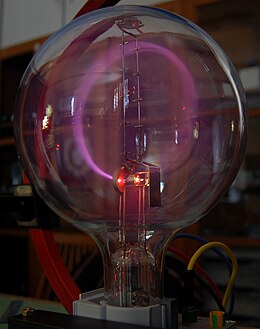
Back أشعة مهبطية Arabic Катоднае выпраменьванне Byelorussian Катоден лъч Bulgarian Raigs catòdics Catalan Katodové záření Czech Elektronenstrahl German Καθοδικές ακτίνες Greek Rayos catódicos Spanish Elektronkiir Estonian Izpi katodiko Basque
This article needs additional citations for verification. (February 2011) |

Cathode rays or electron beams (e-beam) are streams of electrons observed in discharge tubes. If an evacuated glass tube is equipped with two electrodes and a voltage is applied, glass behind the positive electrode is observed to glow, due to electrons emitted from the cathode (the electrode connected to the negative terminal of the voltage supply). They were first observed in 1859 by German physicist Julius Plücker and Johann Wilhelm Hittorf,[1] and were named in 1876 by Eugen Goldstein Kathodenstrahlen, or cathode rays.[2][3] In 1897, British physicist J. J. Thomson showed that cathode rays were composed of a previously unknown negatively charged particle, which was later named the electron. Cathode-ray tubes (CRTs) use a focused beam of electrons deflected by electric or magnetic fields to render an image on a screen.
- ^ Martin, Andre (1986), "Cathode Ray Tubes for Industrial and Military Applications", in Hawkes, Peter (ed.), Advances in Electronics and Electron Physics, Volume 67, Academic Press, p. 183, ISBN 9780080577333,
Evidence for the existence of "cathode-rays" was first found by Plücker and Hittorf ...
- ^ E. Goldstein (May 4, 1876) "Vorläufige Mittheilungen über elektrische Entladungen in verdünnten Gasen" (Preliminary communications on electric discharges in rarefied gases), Monatsberichte der Königlich Preussischen Akademie der Wissenschaften zu Berlin (Monthly Reports of the Royal Prussian Academy of Science in Berlin), 279-295. From page 286: "13. Das durch die Kathodenstrahlen in der Wand hervorgerufene Phosphorescenzlicht ist höchst selten von gleichförmiger Intensität auf der von ihm bedeckten Fläche, und zeigt oft sehr barocke Muster." (13. The phosphorescent light that's produced in the wall by the cathode rays is very rarely of uniform intensity on the surface that it covers, and [it] often shows very baroque patterns.)
- ^ Joseph F. Keithley The story of electrical and magnetic measurements: from 500 B.C. to the 1940s John Wiley and Sons, 1999 ISBN 0-7803-1193-0, page 205
© MMXXIII Rich X Search. We shall prevail. All rights reserved. Rich X Search